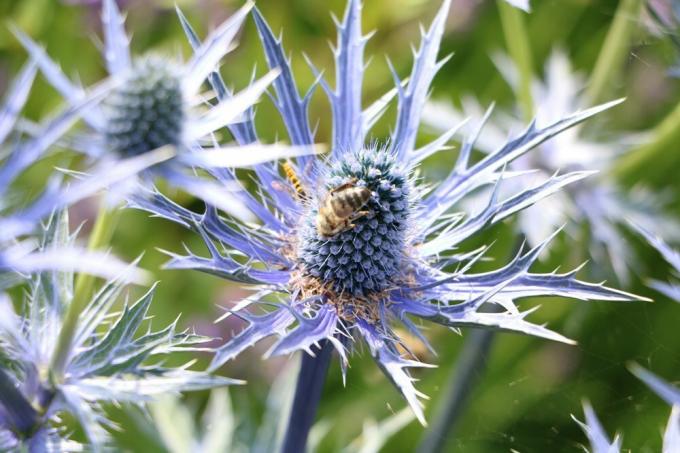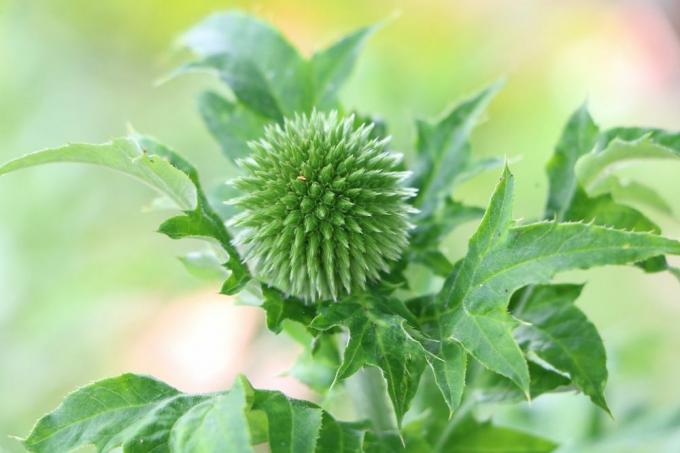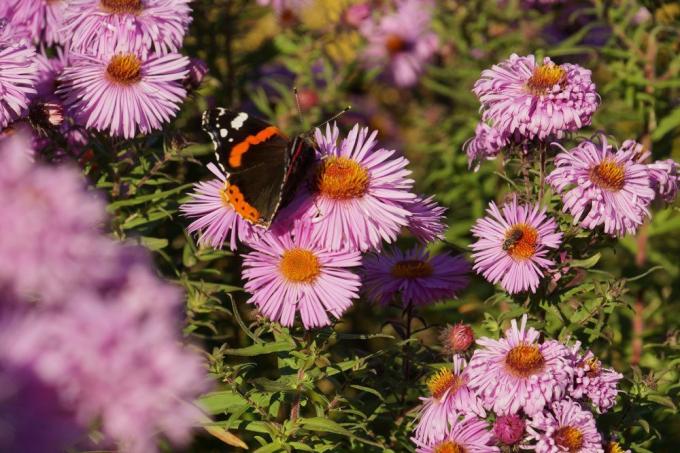
table of contents
- Care instructions
- sowing
- Heyday
- Soil condition & location
- Fertilizing & watering
- Diseases & pests
- Bucket cultivation
- plants
- Plant neighbors
- Cut
- Overwinter
- Repot
- Multiply
Profile and care information open +conclude -
- Flower color
- purple, blue
- Location
- Sunny
- Heyday
- July August
- Growth habit
- upright, clump-forming, perennial
- height
- up to one meter high (in exceptional cases), usually about 60-80 centimeters
- Soil type
- stony, sandy
- Soil moisture
- very dry, moderately dry, fresh
- PH value
- neutral, weakly alkaline, weakly acidic, alkaline
- Limescale tolerance
- Calcium tolerant
- humus
- rich in humus
- Poisonous
- no
- Plant families
- Umbelliferae, Apiaceae
- Plant species
- Bedding plants, Potted plants, Perennials
- Garden style
- Natural garden, perennial garden, rock garden
The Alpine man litter is a blue thistle that belongs to the perennial group. The plant has its home in Central Europe and can therefore also be found in many local gardens. It is a popular perennial especially in near-natural cottage gardens, as it is also a real magnet for bees, bumblebees and others
insects is. But stone or prairie gardens are also the right location. Care is also very easy if it is done according to the right instructions, because the perennial plant is very frugal and gets along well with many soils, especially limestone ones.Care instructions
Extremely beneficial: the blue thistle copes well with both drought and little fertilizer and forms its beautiful blue thistle blossoms again every year. The one that grows up to a meter high Thistle is a great attraction in the garden for bees and bumblebees, but also other insects such as butterflies. As a very tall perennial, it can also form a small privacy screen around a seat over the summer months or replace a small fence. In the colder months, however, it should be cut back according to the instructions so that new, long stems with beautiful blue flowers can form in the next year. It is possible to cultivate the blue thistle in a tub on the balcony, but then it needs winter protection, which is not necessary when planted in the bed.

sowing
The Alpine man litter usually sows itself. Because the large, round flower umbels form many seeds, which fall off with the flower head after flowering and are spread by the wind. So they not only fall to the ground around the garden bed, but can also spread in a wider area. If this is to be avoided, the flowers must be cut immediately after they have faded. How to sow the seeds:
- sow in autumn
- Use a shallow bowl or pot
- fill with sand
- Seeds are cold germs
- just press it lightly into the sand
- Set up in a sheltered, covered area outdoors
- Let stand over the winter
- pour only a little
- plant out in spring
Tip: Alternatively, you can put the seeds in the pot on the last warm days in August, then you can use them Finished small plants of the noble thistle can also be planted in the garden bed before winter, if the climate allows it.
Heyday

The alpine man litter has its main flowering period in the months of July and August. Occasionally, depending on the care taken, especially the climate and weather, there may be a bloom as early as June. Likewise, the flowering can be extended into September even in a long, warm autumn. This also depends on the rainy days in summer. If a summer is very wet, the flowering is shorter and less than in a summer with many sunny and warm days.
Soil condition & location
The ideal location for the alpine man litter is sunny, sheltered from the wind, the soil should be permeable to water and stony. Then hardly anything needs to be considered in further maintenance. Therefore, attention should be paid to the following:
- in a sunny front yard
- Rock garden is ideal
- in front of a wall or hedge with direct sunlight
- Wind can break the stems
- if there is not enough sun, the flower will fail
- Enrich the garden soil with stones
- alternatively mix in a lot of sand
Tip: You should not plant the sun-hungry blue thistle under tall bushes or trees, as it receives too little sun here. The north side of a house wall is also not a good location for the perennial.
Fertilizing & watering

Eryngium alpinum requires little water. It is also not absolutely necessary to water with collected rainwater, as the perennial is very tolerant of lime and even needs lime for its beautiful growth. Tap water that is permeated with lime is sufficient in some areas to supply the plant with enough lime. If this is not the case and the tap water is quite low in lime, lime must occasionally be sprinkled on the ground for proper care. Otherwise, the following should be said about fertilizing and watering:
- Pour only moderately
- in summer only in hot periods
- Soil better dry than wet
- longer drying times are well tolerated
- Avoid waterlogging at all costs
- can be fertilized with organic perennial fertilizer
- pay attention to the manufacturer's instructions
Diseases & pests
The thorny leaves of the thistle act as natural protection and hold Pests remote. There are no known diseases in the robust plant. Only too much water and the resulting waterlogging can damage the plant, as this can lead to root rot in Eryngium alpinum.
Bucket cultivation

The alpine man litter is also suitable for cultivation in the bucket. Depending on the size of the container, it is advisable to use only one plant at a time, as the root ball also increases over time. If there are too many Eryngium alpinum specimens in a confined space, repotting will be necessary more quickly. When cultivating in a bucket, the following must be observed:
- it is essential to put on drainage
- Stones or pottery shards over drain hole
- plant fleece above
- Use garden or cactus soil
- mix with small stones, gravel or sand
- Put half of it in the tub
- Insert perennial
- Fill in the rest of the soil
- pour easily
During the care afterwards, care should be taken to ensure that not too much is poured in the bucket. The Alpine man litter also needs little fertilizer here. Also, when cultivating in a bucket, ideally pour tap water so that enough lime is supplied.
plants
Alpen-Mannstreu can be purchased and planted in stores. But even after sowing in a container or a divided perennial, you will plant it in a new location. You should adhere to the following instructions:
- Perennial grows wider and wider over the years
- therefore a maximum of four plants per square meter
- Excavate earth
- Mix with stones, gravel or sand if necessary
- Earth must be very permeable
- Create drainage in the planting hole
- Use stones, gravel or pottery shards
- Insert perennial
- Fill in soil
- pour easily
Water more often, but only moderately, for the first few days so that the Alpine man litter can grow on well. The best time to plant is in spring before the new shoots or in late summer and early autumn after flowering. However, the days must still be warm enough so that the plant can still form a sufficiently large root ball before winter.
Tip: In contrast to many other plants, Eryngium alpinum does not tolerate compost. Therefore, when planting, you should definitely not prepare the soil in the garden bed with compost.
Plant neighbors

All shrubs that grow in calcareous soils and in sunny places are suitable as plant neighbors for the lime-loving Alpine man litter. These include:
- Asters (astereae)
- Blue pillow (Aubrieta)
- Chrysanthemums (Chrysanthemum)
- Loquat (Amelanchier ovalis)
- Forsythia (Forsythia x intermedia)
- Gladiolus (gladiolus)
- Bluebells (campanula)
- Hyacinths (hyacinthus)
- Crocuses (Crocus)
- Daffodils / daffodils (Narcissus)
But also carnations (Dianthus), Peonies (Peonies), flame flowers (phlox) or Roses (Rosa) belong to the lime-tolerant or lime-loving species Flowering plants. If these plants are mixed brightly in the garden bed, early and late bloomers will join together and the bed will remain colorful throughout the entire vegetation year.
Cut
The Alpine man litter should be cut back close to the ground in autumn before winter. In this way, the plant can keep its hibernation and sprout again in spring. If you want to prevent the seeds from spreading throughout the garden, you should make sure that the flowers are also removed immediately when seeds begin to form. Normal garden or rose shears are sufficient for cutting. This should be sharp and cleaned and disinfected before use. Otherwise nothing else needs to be considered when cutting.
Overwinter

Source: Heinz Staudacher, Alpine litter (Eryngium alpinum) with hoarfrost, Edited by Gartenlexikon.de (MKr), CC BY-SA 4.0
A noble thistle in the garden bed does not need any winter protection here, because it can withstand temperatures down to -28 ° Celsius. However, like all other hardy plants, it needs a little protection when cultivated in a tub. So far, the following tools have proven to be successful:
- Place the bucket on a wooden or styrofoam plate
- Cover with brushwood mats or plant fleece
- sheltered corner on the balcony or terrace
- water occasionally
Note: In the case of potted plants, the roots are less well protected from the ingress of cold and frost. Because this can get to the roots much faster through the bucket wall and the little soil available here. Therefore, you should always offer plants cultivated in the tub a little protection in winter, even if they are considered to be absolutely hardy.
Repot
If Eryngium alpinum was cultivated in a tub for a terrace or balcony due to the lack of a garden, the plant does not necessarily have to be repotted here. Because it needs few nutrients, which is otherwise often a reason to repot a plant in order to receive new nutrients. Only when the roots have become too big can the plant be divided and some of it can be put back in the old bucket. A new substrate is used for this, which is again a mixture of garden or cactus soil as well as small stones, gravel or sand. When repotting, the procedure is as described under the point "Cultivation of tubs".
Multiply
Division is the most recommended variant to multiply Alpine man litter. However, it is not necessary for better growth. The procedure for propagation is then as follows:
- Divide in autumn after cutting
- alternatively in the spring before the first budding
- Divide potted plants when repotting
- Take roots from the earth
- Cut in the middle with a sharp knife
- alternatively, pierce the earth with a spade
- take only half of the earth
- Use again as explained under "Plants"
Tip: If you divide the Alpine man litter in autumn, the days should still be warm enough so that the divided plant can grow well in the new location before the cold temperatures. A daytime temperature of around 20 ° Celsius is ideal in such a case. If you missed the right time, it is better to wait until next spring before dividing and multiplying.



